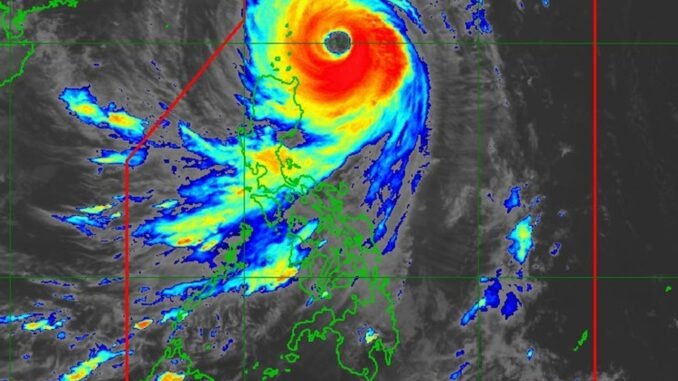
Ameteorologist has pointed out the sheer size of Typhoon Kong-rey’s eye as the massive storm approached Taiwan on Wednesday.
As of Wednesday afternoon, Typhoon Kong-rey had maximum sustained winds of 130 mph, according to the website Zoom Earth. The storm has weakened slightly since Tuesday night, when it was categorized as a super typhoon with maximum sustained winds of 150 mph, equivalent to a Category 4 hurricane. Forecasts anticipate that Typhoon Kong-rey will weaken further by the time it makes landfall in Kaohsiung in the early morning hours on Thursday.
On Tuesday night, meteorologist Noah Bergren of TV station WOFL in Orlando, Florida, commented on the size of the storm’s eye.
“Super Typhoon Kong-rey is easily one of the largest eye’s in a major tropical system you will ever see on Earth,” Bergren posted on X (formerly Twitter). “Thing is absolutely massive.”
A wave crashes outside of Fugang Harbor in Taitung, Taiwan, ahead of Typhoon Kong-rey on Wednesday. The storm is expected to make landfall in Taiwan early Thursday morning. Annabelle Chih/Getty
AccuWeather senior meteorologist Alan Reppert told Newsweek that having a large eye doesn’t necessarily imply anything about the storm’s strength.
“It just means the winds with it are farther away from the center than if it was a smaller eye,” he said. “It doesn’t necessarily have any major defining characteristic of the storm.”
Reppert added that a stronger storm that’s been around longer usually has a wider eye than a newer storm.
Most spaghetti models—or computer models illustrating potential storm paths—show Kong-rey making landfall on Taiwan’s southeast coast and cutting across the island before emerging with maximum sustained winds of around 75 mph. Models indicate that the typhoon will exhibit a northeastern turn away from China, which will take it out to the East China Sea.
Kong-rey’s strength is uncharacteristic for this time of year, The New York Times reported, adding that the typhoon is expected to make landfall equivalent to a Category 4 hurricane.
Reppert warned that strong winds up to 140 mph with higher gusts could hit southern Taiwan, though the storm is expected to weaken as it moves over the island. An AccuWeather report warned of “significant structural damage, mudslides and landslides” from the storm, as up to 3 feet of rain is expected to lash Taiwan. The storm could either maintain its intensity or strengthen before it makes landfall early Thursday.
Eastern China and Japan also are expecting heavy rain as the storm progresses.
A typhoon is classified as a severe tropical cyclone occurring in the Northwest Pacific. A hurricane is the term for the same type of storm in the Northeast Pacific and Northern Atlantic. Outside of these regions, the storms are called tropical cyclones.
Terrified dog set to be put down: Just watch the incredible reaction when she realizes she’s saved

The sad truth is that dogs who are underweight or emaciated often wind up in animal shelters. It pains me to see creatures endure suffering until they are almost unrecognizable.
Despite being mistreated, some animals still have affection and trust for people, while others shrink in fear when they see a rescuer. It is not worthwhile to periodically reflect on what the latter have experienced.
It seems inconceivable to me that I could ever wish to cause harm to an animal. Furthermore, I find it inconceivable that anyone could derive any sort of pleasure from doing this.
That being said, I think dogs have a sixth sense that lets them tell the difference between good and terrible people.
Individuals who care with animals understand the significance of giving a neglected animal the chance to make contact. While playing and petting a dog to reassure it that you are not a threat is natural, it’s not always the greatest idea to do so.
Some folks just find it incomprehensible that a dog that has experienced cruelty might be surprised by a stranger.
Edie, the mixed-breed abandoned dog, would be euthanized in a few hours. She was terrified of people, and it had been a very long time since anyone had showed her any concern. Her fur was disheveled and she appeared to be severely malnourished.
You had to be an actual animal lover to give Edie another chance.
Watching the initial part of the video is difficult. Edie doesn’t know what to do because she is so afraid. She shakes her whole body and lets out a bark because she thinks this man is a threat.
But in the end, the man in the video is able to seize Edie and stop her from running away. He can now be near her.
The creation of a trust agreement proceeds swiftly after that. Edie begins to see that his intentions are not malicious; rather, they are to assist her. She virtually shows the moment she realizes she won’t be put down any longer.
Watch Edie’s reaction in the video below as she learns she’s been saved:



Leave a Reply